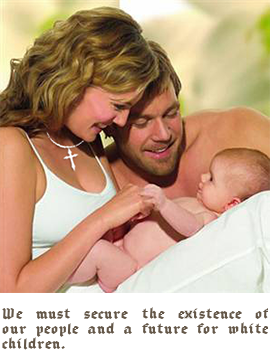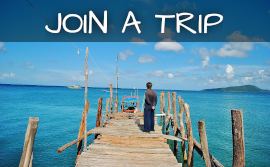Expedition to the Iraqi Kurdistan 2017
Expedition to the Iraqi Kurdistan 2017
Description of my trip to the Iraqi Kurdistan. Iraqi Kurdistan is a country surrounded by enemies which fights for its independence. Despite the difficult political and economic situation, Kurdistan is worth exploration and differs from the Arab Iraq, with the capital in Baghdad. This report should be treated as a guide to northern Iraq, administered by the Kurdish regional government.

Brave Kurdish army, which fights ISIS and struggles for independence. Pictured is the loved by Kurdish people, the President of the Iraqi Kurdistan Masoud Barzani.
Introduction
Iraq is usually associated only with war, terrorism, chaos and the infamous Islamic State which cuts off heads for “infidelity” to Allah. Not many people know about the”other Iraq” in its northern part, which is controlled by the Kurdish Regional Government. The Kurdish part of Iraq is safe, economics and infrastructure are growing and this is the place where they behead ISIS fighters. On the other hand, as a Polish traveller I was treated well and I saw that the Kurds wanted me to have a good opinion about their country. In Kurdish Iraq I spent 2,5 weeks, I was hitchhiking, I walked during days and nights and I saw a lot of guns, but I came back in one piece.
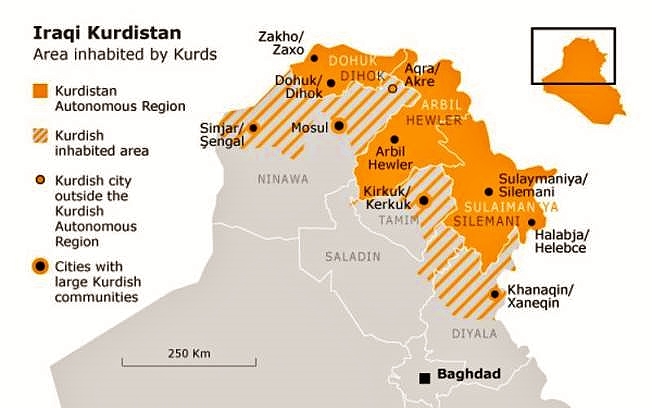
The map of Iraqi Kurdistan.
I would also like my readers to understand that even though Kurdistan is safe, weapons at every turn, military controls, roadblocks, concrete bases and ISIS in the neighborhood make it a region of surprises. If a country or a region looks that way, that is always a reason and Kurdish soldiers are very sensitive to Arab trucks which transport fruit and vegetables, as they can import explosives. Besides, the Kurds don’t just fight ISIS. They also lead a guerrilla war against Turkey, they have unfavourable Syria and Iran next door, and they are not keen on Arabs too.
Referendum on the independence of the Iraqi Kurdistan
Because of the independence referendum drivers made noise on the roads, children wore “free Kurdistan” t-shirts and the entire city and also the whole of Iraqi Kurdistan was decorated with flags and advertisements promoting the “yes” vote in the referendum on Kurdistan independence which was held on the 25/09/2017. People were very exited because even on the vegetable market they posed to photos with Kurdish flags and photos of their leader. The most respected and loved man by the nation is Barzani who in my opinion is not just a leader anymore but the icon of Kurdistan.
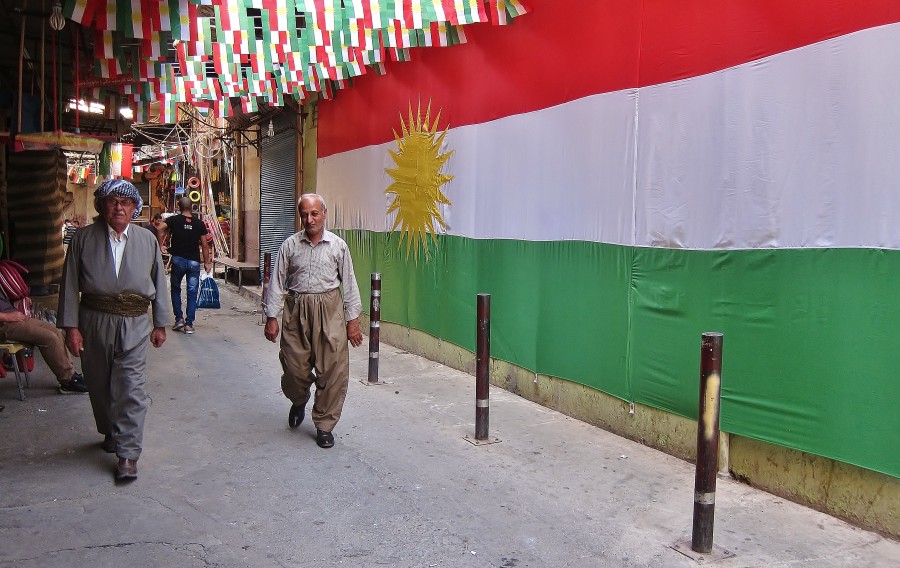
Kurds at the background of a Kurdish flag.
The Kurds have benefited greatly from the American invasion of Iraq and that’s why in the case of independent Kurdistan it could be a pro-American country in the heart of Arab soil. However, Iraq, Turkey, Iran and Syria are certainly against free Kurdistan and I suspect that not a single country would recognize Kurdistan, apart from one Israel to further divide the Muslims.
My tour of Iraqi Kurdistan
The Ibrahim Khalil border
I crossed the border at Ibrahim Khalil which is the only border crossing available to foreigners. Of course everybody was very surprised to have a tourist in the country, because Iraq is not a very popular destination. At the border crossing there were many trucks traveling from Turkey, and there was also a large metal structure with the flag of Kurdistan. The Iraqi flag was also there, but it was smaller and on a side. I also felt that the border was well organized and that immigration went through very quickly.
The Kurds at the border laughed out loud, when I told them that I was a tourist, but they stamped my passport and wished me good luck. Importantly, the visa I got showed: “Republic of Iraq”, what means that I was officially in Iraq. Nevertheless, I was only entitled to travel for a maximum of 30 days in Northern Iraq, controlled by the Kurdish regional government. I suspect that at the airport in Baghdad my visa would look a bit different. I felt that this was the beginning of my beautiful adventure with a thrill.

Border of Ibrahim Khalil between Turkey and Iraqi Kurdistan.
Transport from Ibrahim Khalil to Zakho
From the Ibrahim Khalil border I got a lift by two cars to the city of Zakho, which lasted about half an hour. Zakho is about 10 km away from the border, and I had to stay there for a night anyway. During my journey I only saw the desert, trucks, several cars with rifles on the roofs, and many Kurdistan flags. On that hot day I was heading to my first city in Iraq, and sometimes I wondered whether I was definitely in the right place. One of the cars had a hole in the front screen, which would perfectly fit a bullet. Things of that kind put me into a slight embarrassment.
Each of my drivers wanted to know why I chose Iraq for my vacation, and not Antalya for example. I was wondering too. In such circumstances of desert nature I got to Zakho. First, I saw the a Kurdistan flag on the block, and then a concrete surrounding in a colour of a desert.
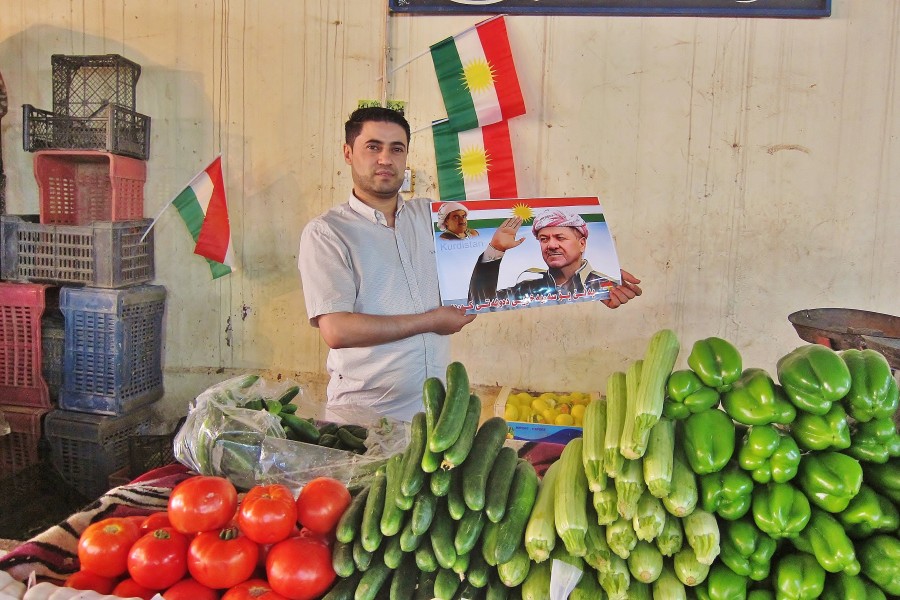
Kurdish patriot with a photo of Barzani.
Zakho
Zakho was my first experience of the Iraqi Kudistan, and I admit that I liked it a lot. In Zakho I had very good contact with people. From the hotel I had a view of the main square with fountains, where there were patriotic concerts after dark. I was at the vegetable bazaar, where people posed with me to photos, whilst holding photos of their leader – Barzani. Everyone was very curious why I came in, and the others were suspicious of me because Iraq was at war. I also sat down many times on the street to drink tea, what gave me the opportunity to get to know Zakho and its people a little bit better.
The whole city was decorated because in four days there was supposed to be a referendum on the independence of Kurdistan from Iraq. There were posters everywhere encouraging to vote “YES”, and people were excited. I also consider the Kurdish fashion among men to be really interesting and original. It is a loose costume and a headscarf, which I think that are practical in a desert climate.

Delal bridge in Zakho.
Whilst walking in the streets I didn’t see a lot of traffic on the roads, but the road signs pointing Baghdad and also Mosul I found to be very interesting – especially that at that time it was occupied by ISIS. Just to think that I was only about 2 hours away from the “action”. After some time I got to Khabur River, to see the historic Delal bridge, built of stone. The Delal Bridge is a popular tourist attraction of northern Iraq, which is why this place is a popular meeting place for families. Around the bridge I saw fruit and sweets sellers, and of course the Kurds were curious about what a White was doing in their country. I took a lot of pictures over there, and every time it happened people posed with the flag of Kurdistan. I felt the approaching referendum. Not far from the bridge there are also ruins of Zakho castle, but there isn’t much left of it.
The Delal bridge is 16m high, but still I saw daredevils who jumped from it, despite the water seemed to be shallow. Either way, I couldn’t stand the heat anymore. It was so hot that I took my clothes off and bathed in the river near the boys smoking cigarettes. People of course were very interested in me because tourists in Iraq simply don’t exist. (Similarly, when I was traveling around Turkish Kurdistan, people were also surprised when they saw me, because the situation in eastern Turkey is very tense).
I spent the rest of the day at the bazaars, talking to people and having tea. I find Zakho to be a very nice small town.

Kurdish patriot in Zakho.
Transport z Zakho do Dohuk
I got to Dohuk by a shared taxi for 5000 dinars, what took me less than an hour, because the distance was only about 60 km. Along the way, I saw a desert and many trucks. Road signs were also very interesting, because some of the places shown on them were described in England as the cradle of terrorism. I don’t deny this, but I think that the only information missing was: “Isis invites to Mosul – just 100 km”. I skipped that “attraction”, although I felt that if I had an army, I would like to go to ISIS to carry out the Catholic revolution.
Dohuk
Dohuk is the first big city in the north of Iraq, to which every traveler arrives from Turkey (Turkish Kurdistan). It is there where Turkish trucks have their first stop, so especially when most of Iraq is still at war, it is in Dohuk that they are deployed to other parts of the country. Dohuk has a lot of shops and bazaars, and of course a large mosque with a high minaret, but also a functioning and well-kept Catholic church. In Dohuk there is also a zoo, which I visited, and behind the city there was a dam under which I swam on yet another hot day.

Direction for Mosul, if someone wanted to experience an adventure with a thrill.
In Dohuk I got to know the Kurdish way of life in a bigger city. Whilst there I drank tea on the street with Kurds, what let me experience the nature of the Kurdish society, and it was in Dohuk where I really started to get to know the atmosphere of Kurdistan. The centre of the cultural and social life of Dohuk is of course a mosque, and a large bazaar around it, where crowds of men drink tea. People were very suspicious about me, but they also had positive attitude. The tea seller asked why I came to Kurdistan, and the crowd in the street had exactly the same question. Well, I sat down, I look around and tried to make an impression of someone who is very relaxed.
I spent most of my time at the bazaar decorated with the Kurdistan flags. I spoke to the experts at repairing phones and cleaning shoes, and of course to people drinking tea. As for the places in Dohuk, which I recommend it is definitely the Central Mosque on the top of the hill, although it didn’t impress me too much, because I saw better ones in Iran. I preferred the Saint Ith Llath Catholic church, because it was clean, well-kept and regular masses are still held. This church must be seen, especially as it is in Iraq. I connected the trip to the church with the zoo, which is in my opinion a very pleasant place. I liked big parrots and toucans the most, whilst the Kurd’s favorite animal was probably me.
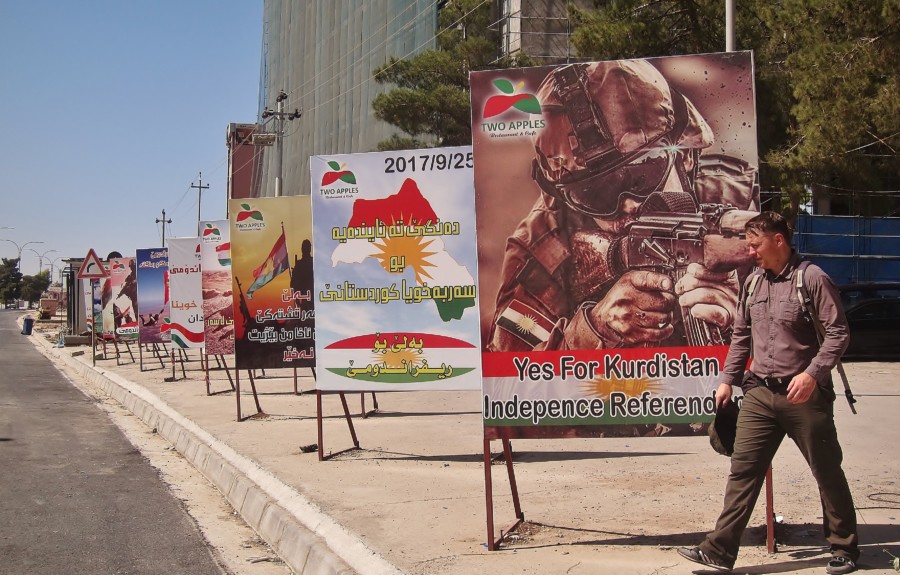
Photo from Dohuk in front of propaganda poster, near the zoo.
When I saw the church, the bazaar and the zoo, and when I already had many pleasant conversations whilst having tea, I went to see the dam outside Dohuk, with its 60m high walls. I hitchhiked over there, and I admired the views for a long time . Then I swam and I took a shower under an artificial waterfall in the mountains, near the road. The Kurds could not get over it, and asked me if it was a Polish habit.
By the way, I think that the area under the dam would be a great place to relax, for regular picnics for example. Unfortunately, there is too much rubbish there to be possible.
Lalish
From Dohuk I went to the Yazidis’ temple in Lalish, to get to know the way they live. Lalish is a small settlement in the mountains which is worth going to, but I must admit that I had mixed feelings. The Yazidis were nice, they offered me tea and they wanted to talk to me as much as their English allowed. Unfortunately I noticed some religious fanaticism there, because the temple was only in one small place, but nevertheless it was necessary to walk barefoot around the whole village, because according to them, supposedly “the entire settlement was a temple”. I advise everyone to take flip flops and wear them in secret, to not to injure your feet. In addition, young Yazidis told me that the head of their community they were calling: “Father.” I’m certainly not a specialist in their “religion”, but given my first impressions, all these things smell like a sect. Whether it is harmful or not, I cannot say, but I suspect that they are good people on a wrong path. The village was very nicely located and it was also attractive. The temples themselves are pleasing to the eye and worth seeing, but they don’t take the breath away.
In Lalish I also had an interesting conversation with someone who introduced himself as sheikh Khalifa, and who regretted that Saddam Hussein was removed from power. In his opinion, it was better for ethnic and religious minorities under Saddam’s rule. I do believe it, because when Saddam Hussein was in power, first of all there was no ISIS, which according to the UN estimates, murdered 5,000 Yazidis. At the moment, I can only be sorry, especially that the West is responsible for the creation of those mas-murderers.
There is no public transport to Lalish, that’s why I had to take a private car from Dohuk for $30. The distance is about 50km, or less than an hour’s drive. I recommend this trip.

In front of the Yazidi temple in Lalish.
Amadiya
Another time I went by minibus to the Amadiya plateau (1400m above the sea level). I went there mainly to see the Badinan gate, but I saw and experienced a lot more. The final part of my road was very picturesque, because wherever I looked, there were mountains and valleys around me. When I finally got to the Amadiya plateau, I saw the town and people living there. One Kurd gave me a lift to the centre, near the polling station, where people still had their fingers soaked in ink, as proof that they voted. Whoever I talked to, they all voted for the independence of Kurdistan.
The history of Amadiya dates back to the time of ancient Assyria, when the city was named Amedi, around the 25th century BC. It is therefore a historic city where there is a church, and a mosque from the 12th century, and to this day this Kurdish village has a population of about 11,000 people. Ammadiya has always been of great importance because of its strategic location, first for the Assyrians, later for Sassanids and also to Arabs, who conquered Ammadiya in the 7th century. The Amadiya gate is everything that has remained to this day from the ancient citadel.

The historic Amadiya gate.
I felt good in Amadiya, because I met nice people who even offered me a sleep over in one of their houses. I was also in a few stores to see people at work, and to get to know how this ancient city functions today. Not far from the high minaret, there was of course a Kurd who grilled skewers, and I tried them, what gave me another chance to have good contact with this nation. The view from the top was great, but I had other plans for the night.
Sulav
A few kilometers down from Amadiya there is a very interesting resort called Sulav, where I took some rest next to a mountain stream, and where I had a room inside a cave, through which flowed a stream. Going upstairs, I passed restaurants under the open sky, with the tables and chairs arranged in a shallow stream. Then I saw a blue swimming pool and a bridge built identically as the Delal bridge in Zakho. Water was pouring from the mountains, so it was a very smart way to use the nature in a safe way. Sulav is a very nice hill station, with attractive views and clean air, but the water is freezing and not everyone would dare to swim over there.
My night was definitely different than all so far, because whole night I could hear water running down the rock, which formed part of the room. I hitchhiked back to Dohuk with a few cars, stopping on the way to take photos.

Panoramic view of the Amadiya plateau, seen from the Sulav resort.
Transport from Dohuk to Akre
My journey was divided into two stages. I got into a shared taxi going to Erbil, but I got off at the intersection where there was a turn for Akre. Suddenly I found myself in a desert, where I saw a few falafel bars, a lot of trucks, and a mast with the flag of Kurdistan. The whole place looked like the first scene from the movie “Terminator Salvation”. I thought: what am I doing here, have I lost my mind? Anyway, I sat down and bought something to drink, and of course everyone was speechless. I could feel that silence and complete lack of trust. I paid for a drink and bypassing the trucks and the sandstorm, I went my way.
I also noticed that this transport hole was also a popular shopping place. I don’t know what kinds of good they throw over there, but I suspect that those of everyday use, so those that don’t explode. In this part of my trip hitchhiking was the only option, and I was lucky because someone stopped quite quickly. I soon reached Akre, and started my next adventure.

A charming interchange place in northern Iraq.
I would like to add that from my place in the desert, where I changed to Akre, there was only about 1 hour drive to the city of Mosul, which was recaptured from the hands of ISIS only in July 2017. I was in Iraq in that place at the end of September, which is why the macabre memories of ISIS were still very much alive over there. In October 2017, the capital of the Islamic State – Raqqa, located in Syria, also fell.
Akre
My arrival to Akre was not easy, but when I got there it was not any better, because I couldn’t find a hotel. They were all very expensive, so I decided to drive down to the Old Town. As soon as I arrived there, people could not get over that a tourist arrive. They were clearly excited. When I got out of the car, the whole crowd stared at me, first in silence and then in euphoria. I also saw a small town with a few shops and an armed fortress. I saw the Kurds with machine guns, and probably also with something much heavier, for special occasions.

Akre – rarely visited but an interesting city. In the lower parts there are bars and tea houses and at the top of the mountain there are ruins of a rocky town, and the cave where I slept.
One soldier came to me, and whilst holding his finger on the trigger, he asked: “And who are you, don’t you know that we have war?” And I replied, “You don’t scare me, just give me a cup of tea.” In that moment that was the smartest though that came to my mind, and I was lucky because someone from the crowd started shouting, that he was selling tea. So I sat in a bar overlooking the suspicious crowd and a few machine guns, and I enjoyed tea and tried baklava.
I felt watched but people were nice, and I somehow I began to find myself in this original situation. Despite everything I felt safe, because it was a protected area 24 hours a day, and not like in England, where every burglar can rob a flat. In Akre, there was a Kurd sitting on the roof with a large cannon. This is what I call security, which in England I could only dream of.

View of the Great Mosque in Akre; northern Iraq.
In the vicinity of the Akre Old Town there is no tourist base, and there is no hotel, but watching people and the way they live gave me a good insight into what Kurdistan really is. My base was a mountain with a ruin of a fortress, where I slept in a cave. It was one of the better adventures of my life, because I slept in a dark cave on a naked stone, and it was so hot that I took my clothes off. Sometimes I like to get out of a clean, organized world, and live like a white animal in a cave, or in a jungle. During the day I was walking around, but the night in the Iraqi cave was the best.
Climbing in the sun was hard but for a strong man this is not a big challenge. On the way up , I saw children who were very curious about me, and saw that they were looking for contact with me. On the way to the top I saw women doing laundry, and the Great Mosque of Akre with a high minaret. The Kurdish people in Akre were good, hospitable and above all very curious. It was obvious that tourist don’t go to Akre at all, because people are simply afraid, and that’s why the locals watched me like a television.

Children from Akre.
During a day I spent time at the top of the mountain or in the Old Town talking to people, and having tea. In the evening the whole village gathered to watch television, and after a few glasses of whiskey I man told me, that when they catch the ISIS fighters, they cut off their hands and their feet to break their fighting spirit. How splendid, I thought, but I was surprisingly very relaxed. I was also happy, that there are still good people who cleanse the world from ISIS.
Transport from Akre to Dohuk
The next morning I went to the road above the Old Town, and left the beautiful Akre. I wholeheartedly recommend this beautiful corner of Iraq. I sat on the road in the company of nice Kurds with machine guns, and waited for transport.
As before, this time I had to change in a transport hole at the crossroads, about 10 km through Akre, which worked on imagination because it looked like a landscape after war. I saw trucks again, a lot of goods and the flag of Kurdistan in the desert.
My trip by a shared taxi went without any complications. The distance between Akre and Dohuk is around 105 km, which I did in about 1.5h. Actually, there was no need to go back to Dohuk, because there are regular taxis to Erbil from the transport location in the desert. At that time I didn’t know what could happen to me on the Iraqi highway, that’s why I preferred direct transport whenever it was possible, and later I used hitchhiking when it was necessary. Besides, I left my big luggage in Dohuk, which I had to pick up.

We waited for a bus together.
Transport from Dohuk to Erbil
I spent my last evening in Dohuk in a pleasant way. I drank tea on the street with local Kurds. As usually I also had an interesting conversation about Poland and the referendum on the Kurdistan’s independence.
The next morning I went by shared taxi to the regional capital of Iraqi Kurdistan – to Erbil. The distance is about 150km, which I did in about 3 hours. I paid 10,000 Iraqi dinars for a taxi seat. On the way, I saw valleys and green areas, not just a desert.
I”d like to mention that I didn’t go through Mosul, as that road is meant for terrorists and suicides.
Erbil
Wprowadzenie
Erbil is the capital of Kurdistan and its commercial and cultural centre. Even during the war Erbil was not bombed, and during that difficult time, since the removal of Saddam Hussein from power, Erbil was being developed. In the regional capital of Iraqi Kurdistan, trade and infrastructure were on their way, and when I was there, I saw that even foreign companies are not afraid to invest. Erbil sets an example for other Iraqi cities, because it indicates the right direction in which this country should go. Erbil is clean, neat, there are many restaurants, attractive bazaars and shopping centres. From the point of view of tourism, the most attractive part of the city is the area around the ancient Citadel.

View of the Citadel in Erbil (Hawler).
As soon as I arrived to Erbil, I immediately went towards the Citadel, and then passing through the bustling bazaar I arrived at the hotel. I paid 15,000 Iraqi dinars for a bed in a dormitory. It was all I needed because the hotel was right by the citadel, and there were good conditions. I had a very good view from there. I want to add that for the best panoramic photo of the Citadel and the square with a fountain I went to a high block opposite, and from there I captured the whole landscape.
From the point of view of tourism, the most interesting object of Erbil is the Citadel, built at the top of the plateau, which rises above the city. In front of the Citadel there is a large fountain, and on its two sides there is a well-stocked bazaar. In Erbil there are also several nice parks, a big mosque with a blue dome and high minarets, and a funfair for children. In one of them you can take a cable car, and in another fly a balloon to see Erbil from a bird’s eye view. I also recommend the very interesting -the Kurdistan Textile Museum, located in the Citadel, and big shopping.
Anyway, whilst in Erbil I went wherever I wanted, at any time of a day or night, and it was always safe. Nothing exploded, and despite a few bomb explosions, let’s not get scared and let’s go to Iraqi Kurdistan.

Citadel in Erbil. The main gate and the flag of Kurdistan.
Places of interest in Erbil
I spent most of my time near the Citadel, near the fountain and bazaars. It was very nice there, and I stayed longer than I planned. However, there are places in Erbil, which I recommend especially:
The Erbil Citadel is a historic desert-colored fortress, which according to the popular opinion was built around the 5th century BC, during the Assyrian Empire. Some say that it could have been built in the 7th century BC. Many religions, ethnic groups, empires and people inhabited Erbil from the earliest evidence of settlement, dating back to 5000 BC. The Erbil Citadel was ruled by Sassanids, Sumerians, Assyrians, Mongols, Ottomans, and Crusaders. Within the Citadel, there were churches, mosques and synagogues, but today there are no permanent residents, even though there are residential houses. In 2010, the Kurdistan Regional Government allocated $ 13 million for restoration of that magnificent sight. As a result of this work, in 2014 UNESCO approved the Erbil Citadel as the world heritage sight, saying that: “The citadel is today one of the most dramatic and exciting places of culture not only in the Middle East, but also in the world”.
The Citadel is indeed nicely renovated, and in front of it, on the way to the top, there is a huge flag of Kurdistan. The front facade has nice arches, smooth walls and balconies, typical of the Muslim architecture. (By the way: I like Muslim architecture, but not in Europe.) Inside the defense walls there are many interesting objects, including a mosque with a dome and minaret in the color of the desert, attractive courtyard, and windows and pillars that add a special character to the Kurdish Citadel. An important place here is the Kurdish Textile Museum, which is a good insight into the cultural heritage of the Kurds. Inside, there are mostly carpets with many patterns and shapes, which turned out to be very interesting for me. The rugs and hats are closely related to Kurdish culture, because this nation, occupying itself mainly with cattle breeding, must have always been self-sufficient.

View of the main square in Erbil, seen from the Citadel. A fountain in the middle and bazaars under the pillars on both sides. Please pay attention to the Kurdish Big Ben on the left.
The Qayssarria bazaar is a renovated shopping place, with high pillars, a new floor, and Kurdistan flags. This bazaar is located south of the Citadel, and I think it is necessary to go there for the cultural experience. The food in Erbil is delicious, as are Arabic sweets, fresh juices, honey and natural yoghurts. Women in Erbil can find nice jewelry, including lapis necklaces – from blue Afghan stones. I liked the atmosphere in Erbil very much. People were very nice to tourists, as they offered their goods, from sweets to clothes and kites, but they didn’t hide that they were surprised by my presence. I think that the bazaar will turn out to be the most interesting place for tourists, because of contact with people. Some people tried to make contact with me, which was easy because I was sociable, and others liked to make fun of me. I was the most frequent client in an Arabic baklava store, because they had real specialties. I also found interesting all the souvenir shops from Iraq and Kurdistan, and soldiers who liked to display their machine guns. I liked the Iraqi bazaar very much.
The area with fountains in front of the Citadel is called Shar Garden Square. In many Arab countries where I’ve been before, fountains are an obligatory part of the city, not only for aesthetic reasons, but also to cool down the hot desert air. This was the case in Bandar Seri Begawan, in Tehran, and in Amman. In Erbil however it is better because there is a path between the fountains, and there are benches too. Even in a dry desert climate, you can feel refreshed, when looking at the Citadel, and even the clock tower modeled on London’s Big Ben.

Minaret Park seen from Shanadar Park. In the background you can see the white gate of the park, the balloon which flew me up, and the historic Muzzafariya Minaret.
There are also several nice parks in Erbil, which make life in this city a lot more pleasant and helps to forget about the war. Besides, there are also many tourists in Kurdistan from the Iraqi part, where the war is still going on. For example, I was in the Minaret Park, which is a large green area, hidden behind white pillars. It is a popular meeting place for families, and couples which are in love use trees to get closer to each other in a public place, against the rules of Islam. One of the main points of the Minaret Park is the Muzzafariya Minaret, which is 36 meters high, and was built around the 13th century. The Minaret Park is connected to the Shanadar Park via a cable car, thanks to which I saw the Erbil panorama. In addition, in the Minaret Park one can eat something good, and take some rest from the city noise. I also flew the balloon for 5000 Iraqi dinars.
It is also worth to mention about the monument of a Kurdish historian, who was born in the Erbil Citadel in 1167. He was named Mubarak Ahmad Ibn Al-Mustawfi, and wrote about several subjects, such as history, literature, and the city of Erbil. Today, his large white monument was moved to the Minaret Park, but a few years ago it was in front of the main entrance to the Citadel.
Shanadar Park, which I mentioned earlier, is another pleasant place with an observation deck of the Minaret, the cable car and a yellow balloon in the distance. There is also an art gallery there, numerous food stores and a central pond. It is a very nice place.

In the Minaret Park before the monument of a Kurdish historian – Mubarak Ahmad Ibn Al-Mustawfi. Erbil, Iraq.
In addition, Erbil offers other interesting places, depending on the interest of travelers. If someone still has not seen enough parks, he can see Sami Abdul Rahman Park, which covers 200 hectares, it has 2 ponds, fountains, restaurants, and an interesting monument with the inscription: “freedom is not free”. I like it. I wonder if in England such an inscription would be tolerated by its “democratic” government? Walking through the streets of Erbil, I also reached the huge Jalil Khayat mosque, with a blue dome and minarets. I went there several times but unfortunately I never had the luck to see its interior. There are also many other interesting places in Erbil, which would require exploration on its own.
!!! Although Erbil was safe in 2017, and it looked like the war did get there, I would like to remind about certain tragic events. Well, in 2005 the Ansar al-Sunna group, which also fought Americans, sent a suicide bomber who carried out a bomb attack in the office of a Kurdish political party. In 2015 ISIS detonated a bomb in front of the US consulate in Erbil, and in 2016 Kurdish services prevented bomb explosion hidden in a passenger car. Bombs in Erbil also exploded in 2018 and in 2019. From my experience, and experience of other travelers Erbil is very safe, but considering those unfortunate events, it is still a city full of surprises.

Martin Malik – the ambassador of peace in Iraqi Kurdistan.
My beautiful mountain trip outside Erbil
Hamilton Road
From the Erbil bus station I went by shared taxi to the mountains, to Rawanduz, which proved to be another beautiful adventure. Before I got to Rawanduz, I had a tea break in the Iraqi city of Shaqlawa, and then I continued on the Hamilton Road, which from the point of view of tourism is very attractive, because it’s a winding mountain route, with many bridges built on river Rawanduz. The Hamilton Road is named after Archibald Hamilton, an engineer from New Zealand, who in 1928- 1932 was the chief engineer of the British strategic road in Iraqi Kurdistan. This road is in use today, and it runs from Erbil, through Rawanduz, to the border with Iran. Transport to Rawanduz through scenic mountain views cost me 15,000 Iraqi dinars.
Rawanduz roller coaster
Rawanduz is located at 150 m above the sea level. and it’s surrounded by mountains and gorges. It is a small town offering great views of the extensive valleys, 107 km from Erbil. However, the town of Rawanduz itself is not as popular as Rawanduz Pank Resort, where there are cottages for rent,
and spectacular, even neck breaking roller coasters running over the abyss, called “shinglbana”. The roller coaster has a length of 1475 m, it is 300 m high, and it travels at a speed of 55 km/h over the abysses. When sitting in one of the cars I had the impression of flying over the mountains, over the Rawanduz valley. I Of course I had a great time, but it is an adventure with a thrill, because I’m sure that many would choose to not to look down.

Rawanduz valley, in Iraq.
Imagine what the media reaction would be like in Poland or in England, if I went to Iraq and died on the roller coaster. The whole of Europe would laugh at me. In that case, I’d rather be killed by terrorists, because then I would at least look like a hero. It reminds me of that scene from the movie, when a soldier’s mother received a letter that her son was killed in the war, but not from the enemy’s bullet; he died of jaundice.
Gali Ali Berg waterfall and the company of Peshmerga patriots
On the way back I stopped at the Gali Ali Berg waterfall, which is the pride of the natural beauty of Iraq, as it was even immortalized on the banknote of 5000 Iraqi dinars.
My route led through a picturesque red canyon. I was driving near the rushing river, and on the red rock formations I could see the flags of Kurdistan. Gali Ali Berg waterfall offers not only peace and quiet. One can float on a pontoon in the company of ducks, and enjoy the cool breeze flowing from the dropping water. I thought I would stay there for only an hour and go back to Erbil, but I stayed whole day and then whole night in the canyon, where I slept on the platform with a few Peshmerga soldiers.
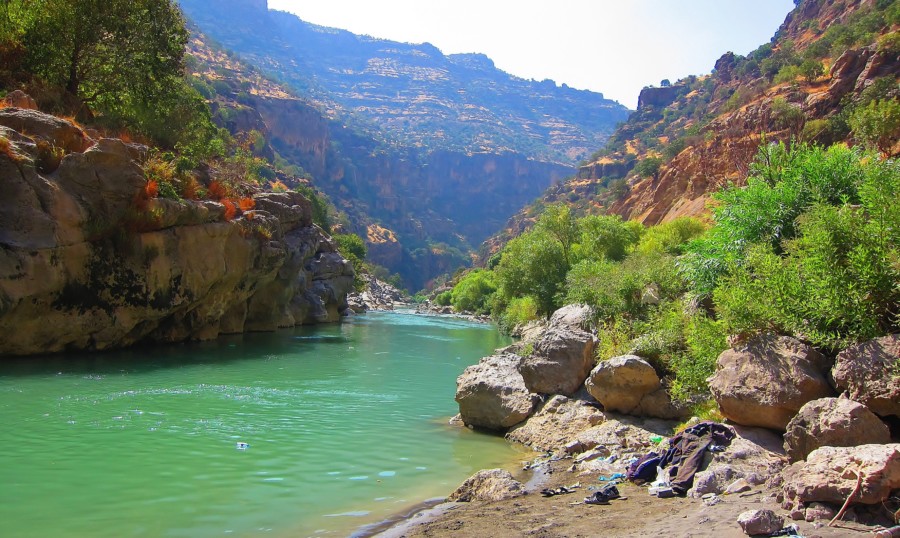
River in the canyon near the Ali Berg Waterfall. I swam there.
The Ali Berg waterfall is very popular with tourists, such as for example with Arabs, who normally live in ISIS-controlled areas, and from time to time they take a rest from the war by the waterfall . Peshmerga soldiers were very nice to me, because they served me tea and scrambled eggs, and they also showed me on the phone how they blow up Turkish armoured vehicles into the air. I admit that it was very interesting, because first I saw a driving a car, and soon after it was completely gone. Whilst traveling around Iraq I saw a lot of weapons, and sometimes when I hitchhiked, I was given a lift by people with machine guns. Anyway, the waterfall and the canyon were beautiful, and I sincerely recommend them. Hitchhiking in Iraq also works well.
People sometimes ask me if I’m afraid, but I don’t think about that, because if I had to worry that in distant countries people are armed to teeth, I would never go for a holiday.
Near the waterfall there was also the so called restaurant in Bekhal Resort, where I ate a good supper for 5.000 dinars, but unfortunately the service was a bit boorish. Even so, I preferred to not to argue over the dry bread that they gave me, because they had the gift of persuasion in the form of machines guns, and I did not. Then I sat down with nice Kurds, where we had good time talking. After the waterfall, I liked the starry night the most, because I slept in the mountains by the river and I fell asleep looking at the stars. It was beautiful, and for such experiences I travel.

Gali Ali Berg waterfall in Iraqi Kurdistan.
Khanzad Castle
On my way back to Erbil I stopped at Khanzad Castle, also called Banman, which is a small 16th century fortress built on a mountain. The castle has 4 towers and it is visible from the road. It is located 22km from Erbil on the way to the town of Shaqlawa, and in my opinion it is a very interesting sight, especially because I love old castles. Not far from there I saw grazing sheep and I went to stroke them to once again experience the rural life of Iraq.
Soon I returned to Erbil, where I saw the Citadel once again, and I tried Arabic sweets.
Transport from Erbil to Sulaymaniya
My last expedition in Iraq was a trip to the southern city of Sulaymaniya, distant from Erbil by 203 km. The journey took me about 3 hours, and I paid 12.000 Iraqi dinars for a place in a shared taxi.
I was driving through Kirkuk which was sad and deserted, even though just before the city stood a large monument of a soldier holding a huge flag of Kurdistan. There was something creepy about Kirkuk, because even the driver was afraid and rushed to get out of there as soon as possible. For that reason I don’t have any photos of Kirkuk, even though really I wanted to.

Khanzad castle; Iraqi Kurdistan.
Shortly after my return to England, the Iraqi army ruled by the government in Baghdad recovered from the Kurds, rich in oil Kirkuk. Although Kirkuk was never in Kurdistan, it had Kurdish population. Unfortunately, the only road from Erbil to Sulaymaniya was via Kirkuk, which Kurds recaptured from ISIS with such difficulty.
Sulaymaniya
Next to Erbil, Sulaymaniya is a large and rapidly growing city of Iraqi Kurdistan, which is very important for the local economy, and it has strong commercial ties with Iran. Sulaymaniya has its own airport, given into service in 2006, an increasing number of cars and with it exhaust gases that cause headaches. Unfortunately, Sulaymaniya does not have historical sights, like Erbil or Dohuk do, but just outside the city there is Asmar Mountain, offering great views and relaxation. Also, even though there is no ancient citadel or Roman ruins (such as in Lebanon for example), in Sulaymaniya and around there is something to do. Sulaymaniya is very popular among local Iraqis, tourists from Arab countries, and now it is also popular with one tourist from Poland – that is me. I write about it, because tourists from Europe sometimes leave the airport in Erbil, just to see the Citadel, and then they fly to Istanbul, and later show off that they “visited Iraq.” To white women I recommend Sulaymaniya for shopping, and they can buy for example nice materials and fake perfumes for much lower price.
In Sulaymaniya I was as usual the only European. Some people were suspicious and others were sincerely glad that someone finally dared to visit them. As soon as I got off the taxi and started walking in the street, a policeman stopped me to ask who I was. I said that I was a tourist, and he smiled under his mustache and asked me: “are you a tourist or a terrorist, because over here it makes a little difference”. What a nice welcome, I thought, but I didn’t want such a little thing to ruin my day. The street in Sulaymaniya was very busy. There were a lot of cars and mopeds, and trucks which I hoped would not explode.

Kebab in Sulaymaniyah.
Then when I went to check in at the hotel, and everyone was of course very surprised to see me, and they asked me why I came. When I said that I was a tourist, they laughed for a long time. Yes, nobody believed me, but it’s probably because those don’t travel at all. I lived in the centre, near the great mosque and a bazaar, near the Zamwa gallery where every evening local vendors sold delicious food. There were various types of kebabs, but also soups, snacks, ajran and fresh juices. The Kurds were smiling, they served kebabs and drinks, and they always wanted to talk about Iraq, about Kurdistan, and about Poland. Someone even asked me if this was true that Poland was really so freezing, and whether we had polar bears. Well…
Sulaymaniya looked like a very decent place, and I thought it was a pity that no one wanted to go there, because it was really nice. Of course there were a few concrete blockades, barbed wire and machine guns, but that’s for security reasons, which is why I think that Sulaymaniya is a very nice tourist town.
Places of interests in Sulaymaniya
Sulaymaniya has also interesting places to see, and the place which I recommend is the Saddam Hussein’s former detention centre – . Currently Amna Suraka serves as a museum, but this facility does not look like an ordinary museum. Outside, I saw armed soldiers instead of cashiers, a thick concrete wall with barbed wire, and heavy cannons in the street. There were still bullet holes in the museum walls, and outside were displayed Saddam’s old tanks, heavy artillery and used bombs. Inside the building there were prison cells, and a shocking exhibition of photos from the Kurdish genocide. There were also newer photos – about the fight against ISIS. Some of the pictures depicting skulls and skeletons of the fallen in the desert were tragic and unpleasant, as well as the documentary produced by the BBC. Noteworthy is also the corridor with pieces of glass on the walls and small lamps on the ceiling, because each of those lights symbolizes a lost life. In the former prison that I visited, people were tortured and killed, until the Kurds took control of the city.

At the former prison of Saddam Hussein, Amna Suraka; Sulaymaniyah.
Zoo in Sulaymaniya was also a very pleasant experience. In front of it which there was a sad amusement park surrounded by ruins. I spent quite a nice time there with the Kurds, who brewed tea on the grill, in the dug-out area. Soon after I went to the zoo, where I saw a few interesting animals, but that was not the most important. It was important that Kurdistan began to revive after the war, and although it is not easy, life is moving forward. There is even a zoo, and the “fun” fair would be eventually renovated. This place is located near the Jaff towers, where there is also a cinema.
On my last day I went to the Zamwa gallery, where I saw interesting paintings, also depicting naked women. The exhibition is being changed, that’s why one can go there many times to always see something new. Zamwa gallery is a popular exhibition place of Kurdish artists. On the way to the gallery I came across a public gathering. People stood with the flags of Iraq and Kurdistan, holding photos of the first president of Iraq after the overthrow of Saddam Hussein. It was Jalal Talabani, an Iraqi-Kurdish who died on the 3rd of October 2017 in Berlin. Talabani held power from 2006 to 2014 and did a lot for the Kurds. It is also interesting that in a country such as England, people hate politicians and when they leave, they treat each of them as a relief, while the death of Talabani was approached very emotionally by the Kurds. Whilst there, I had the opportunity to take some memorable photos.

People in Kurdistan are optimistic.
It was the end of my stay in Sulaymaniya, which I consider to be a very important element of traveling in Iraqi Kurdistan.
Return to Erbil via Dokan lake
I was hitchhiking to Erbil, but I felt that I really wanted to see something else. For that reason I decided to get off at the intersection to the picturesque Dokan Lake, about 65 km away from Sulaymaniya. I walked for a while through the wilderness of Iraqi desert, until a passenger car with several men stopped on the road. The men were so nice that they moved their machine guns, so I could sit down and so we could continue moving forward. By the way, I love such adventures, and I don’t want my readers to take rifles with distaste. It is Iraq after all.
The blue Dokan lake is the beauty of Iraq’s nature, which emerged from the construction of a hydro-electric dam, at the connection of Tanjarow and Sirwan rivers. This place is now a popular tourist destination, with cabins for tourists, eateries, and places to rent a pontoon or a motorboat, and eat fish straight from the lake. My time at Lake Dokan was lonely, although very successful. I swam, I walked in the mountains, I ate a good fish, and spent the night in a desert hut, by the lake. It was a beautiful lonely night under the stars, but as it turned out, the hut belonged to a Kurdish fisherman, so I paid him in the morning for the night. That way I spent two beautiful days, and I hitchhiked back to Erbil.
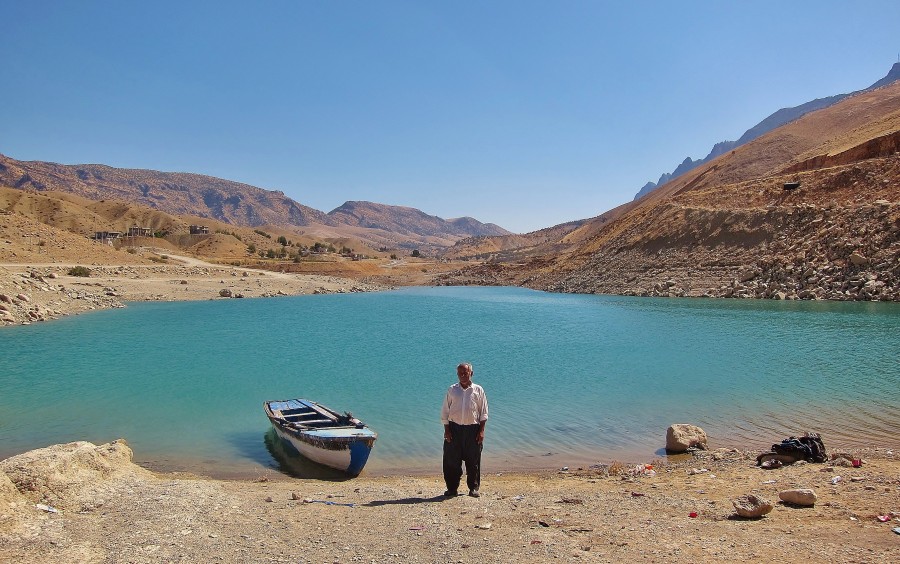
Dokan lake. I don’t want Iraq to be associated only with the war.
My last day in Erbil and transport to Turkey
Strona iracka nie robiła mi problemów, lecz Turcy byli bardzo podejrzliwi i zatrzymali mnie na godzinę na granicy aby mnie sprawdzić. Nad ranem dojechałem do Diyarbakir, lecz to jest już zupełnie inna opowieść.
Na marginesie, strona brytyjska też mi zgotowała specjalne przywitanie po powrocie do Anglii, ale nie chcę rozwijać tego tematu. Czy ja naprawdę wyglądam na takiego, któremu nie można ufać? Zauważyłem, że generalnie ludzie są bardzo podejrzliwi i wręcz zszokowani gdy słyszą o moich podróżach. Wątpie aby byli zazdrośni, ale nie dobrze mnie traktują gdyż wyobraźnia zabiera ich w bardzo ciemne zakamarki.
I spent one more great day in Erbil. Once again I saw the Citadel, and I was at the bazaar full of Arab delicacies. I also went to the Minaret Park, and I realized that that way I was saying goodbye to the Iraqi Kurdistan. The next day, in the evening, I went to the station and I boarded a large bus for Diyarbakir, in the unofficial Turkish Kurdistan. The trip went fine.
The Iraqi side didn’t give me any problems, but the Turks were very suspicious and stopped me for an hour at the border to check me. In the morning I arrived in Diyarbakir, although this is a completely different story.

Iraqi Kurdistan is sweet and it smells with pistachios.
By the way, the British side also gave me a special welcome after my return to England, but I don’t want to develop this topic. Do I really look like someone that cannot be trusted? I noticed that people are generally very suspicious, and even shocked when they hear about my travels. I doubt that they are jealous, but they don’t treat me well, because their imagination takes them to very dark places.
Summary
I consider my trip around the Kurdish Iraq to be very successful, although it is not an easy destination and it’s an adventure with a thrill. The places which I visited was one part of my trip, while hitchhiking was a completely different chapter. When I was traveling there it was a safe, but I advise to check safety regularly. I mean that I don’t want anyone to go to Iraq and be harmed because “Martin Malik advised him so.” I do not advise to go to Iraq. I just tell my story.
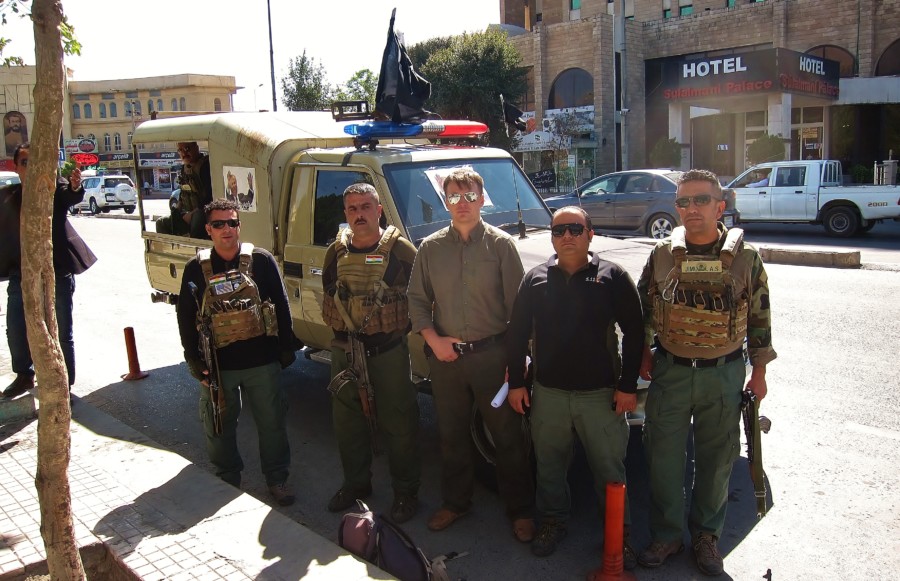
I asked the soldiers for a photo and they were so kind that they agreed. Please pay attention to the machine guns, including the one on the roof of the car. That’s why it is safe and the same strategy I recommend in Europe as a medication for the crimes of multi – “culturalism”. I greet all adventure travellers from Sulaymaniyah.





